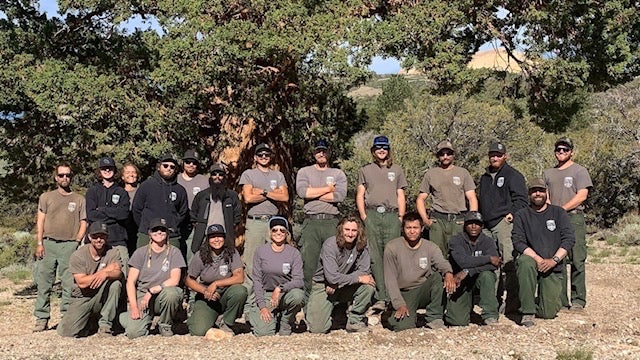What a Wildland Firefighter Wants You to Know About the 2021 Fire Season
By Mekenna Malan | July 19th, 2021

Photos courtesy of Dave Inskeep and Cameron Porter
It's a piece of advice that Utahns should not only know, but actually follow: "Now is not a good time to start a fire."
Dave Inskeep, an Ogden resident and wildland firefighter, knows this better than anyone else. In the interview below, Dave gives some (simple, but so often overlooked) reminders for smart outdoor recreation, links to a few important wildfire resources, and offers a peek into his rigorous but crucial career.
Dave Inskeep has been a supervisory forestry technician—also known as a wildland firefighter—since 2005. “I supervise a 20-person crew," Inskeep says. "We are typically assigned to work 16-hour days, about 14 days at a time.” Those 16-hour days include the suppressing, preparing, preventing and monitoring of wildfires. These tasks are physically demanding, can be dangerous, and are essential for maintaining our outdoor spaces. “Usually we’re working in the field, putting in some kind of field break with chainsaws, cutting hand lines and working our way up the mountain," Inskeep says.
Assigned to the Great Basin (Region 4) area, Inskeep and his crew cover wildfires in Utah, Idaho, Nevada, and parts of California and Wyoming. According to InciWeb, there have been 109 reported wildfires in the western United States since the beginning of July. By the time this interview is posted, likely even by the end of the day, there will be more fires added to that list. “We thought 2020 was a busy season, and we are ahead of 2020 as far as drought conditions go,” Inskeep says. “It’s hotter, drier, and we’re noticing more extreme fire behavior in areas we don’t usually see this early in the year.”

A quick visit to utahfireinfo.gov displays a map of current fire restrictions in the state. It’s pretty easy to read: at the time of this writing, all but about 5% of Utah is overlaid with red, meaning there’s fire restrictions in place almost everywhere. Part of how these restrictions are decided is by calculating the state’s ERC, or Energy Release Component. According to the USDA, “The ERC is a number related to the available energy per square foot within the flaming front at the head of a fire.” With the drought, Inskeep says, Utah’s ERC is much higher than it was at this time last year.

So what can we do? Before recreating in a certain area, it’s important to be aware of nearby fires. One of Inskeep's favorite public resources is InciWeb, a site that offers an exhaustively comprehensive log of active and recent fires. Click a fire on the map and you'll have access to all kinds of information, including the incident’s cause, coordinates, percentage contained, and even the fuels involved. “InciWeb is updated multiple times a day. During fire season, there’s infrared flights all over the sky mapping fires,” Inskeep says. “If you zoom in far enough on the state of Utah, you’ll start seeing little red specks popping up everywhere on the map. As those planes fly, they pick up heat all over the place. You can use this map to see fires way up in the mountains that nobody even really knows about.”
Though some wildfire prevention and safety tips might seem obvious, Inskeep frequently witnesses the effects of negligent people who do the opposite of them. “One thing I always get on a soapbox about is this: If there’s a fire anywhere near mountain bike trails, don’t go mountain biking on the trail,” he says. “You can put up ‘CLOSED’ signs all you want, but somebody will still ride through. Don’t do anything to create a spark. Pay attention to your location. Be careful and watch what you’re doing. And please, don’t move ‘ROAD CLOSED’ signs and drive up to fire locations. You’d be surprised how often this happens.”

The first thing you should do if you see a wildfire, Inskeep says, is make sure you’re safe. “Go the opposite direction of the wind,” he says. “Report the fire, but make sure you’re safe first. Again, it seems obvious, but if you see a wildfire, you should definitely leave the area and get out of the way.”
At the time we spoke, Inskeep was close to finishing a 30-hour shift. Though it's difficult at times, being a supervisory forestry technician is still Inskeep’s dream career. “I’m in my 17th year, and I want to say the best part of this job is the job itself,” Inskeep says. “The camaraderie that you have with the crew, the country you get to see that you typically don’t. You get to challenge people everyday to do a job they never thought they’d be allowed to do. And when else would you actually get to explore such rugged terrain? You get to see some really cool things.”
LOCAL WILDFIRE RESOURCES:
Utah Fire Info
InciWeb
Daily Incident Management Situation Report
Great Basin Coordination Center




